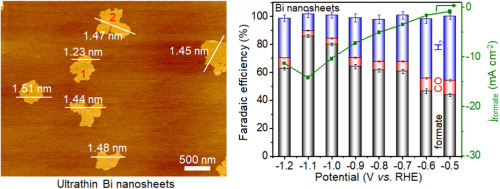Nano Energy ( IF 16.8 ) Pub Date : 2018-09-21 , DOI: 10.1016/j.nanoen.2018.09.053 Wenjun Zhang , Yi Hu , Lianbo Ma , Guoyin Zhu , Peiyang Zhao , Xiaolan Xue , Renpeng Chen , Songyuan Yang , Jing Ma , Jie Liu , Zhong Jin

|
Electrochemical CO2 reduction has been considered as a promising route for renewable energy storage and carbon-neutral energy cycle. However, the selectivity and stability of electrocatalysts for CO2 reduction need to be improved. Two-dimensional (2D) layered electrocatalysts with high conductivity and abundant active sites have been considered as good candidates for CO2 reduction. Herein, we propose a liquid-exfoliation strategy to prepare ultrathin 2D bismuth (Bi) nanosheets towards efficient electrocatalytic CO2 conversion. Compared with bulk Bi, the increased edge sites on ultrathin Bi nanosheets played a vital role in CO2 adsorption and reaction kinetics, significantly facilitating CO2-to-formate (HCOOH/HCOO-) conversion. Through density functional theory (DFT) calculation, we found that the *OCOH formation step tended to occur on edge sites rather than on facet sites, as confirmed by the lower Gibbs free energies. Benefited from the high conductivity and rich edge sites, Bi nanosheets exhibited a Faradaic efficiency of 86.0% for formate production and a high current density of 16.5 mA cm−2 at − 1.1 V (vs. RHE), much superior to bulk Bi. Moreover, the Bi nanosheets could maintain well-preserved catalytic activity after long-term testing for over consecutive 10 h. We hope this study may provide new insights for the fabrication of novel 2D nanostructured metals for highly-efficient and long-life electrocatalytic CO2 conversion.
中文翻译:

液相剥落超薄Bi纳米片:揭示二维金属纳米结构上增强的电催化CO 2还原的起源
电化学还原CO 2被认为是可再生能源存储和碳中性能源循环的有前途的途径。然而,用于CO 2还原的电催化剂的选择性和稳定性需要提高。具有高电导率和丰富活性位点的二维(2D)层状电催化剂已被认为是CO 2还原的良好候选者。在这里,我们提出了一种液体剥离策略,以制备超薄的二维铋(Bi)纳米片,以实现有效的电催化CO 2转化。与块状Bi相比,超薄Bi纳米片上增加的边缘位点在CO 2吸附和反应动力学中起着至关重要的作用,从而显着促进了CO 2的吸收。-to-甲酸(HCOOH / HCOO - )转换。通过密度泛函理论(DFT)的计算,我们发现* OCOH形成步骤倾向于发生在边缘部位,而不是在刻面部位,这由较低的吉布斯自由能所证实。受益于高电导率和丰富的边缘位置,Bi纳米片的甲酸生产效率为86.0%,在-1.1 V时的电流密度为16.5 mA cm -2(相对于RHE),远优于块状Bi。此外,Bi纳米片经过长期测试连续10小时后,仍可以保持良好的催化活性。我们希望这项研究可以为新型2D纳米结构金属的制备提供新的见识,以用于高效且长寿命的电催化CO 2 转换。










































 京公网安备 11010802027423号
京公网安备 11010802027423号